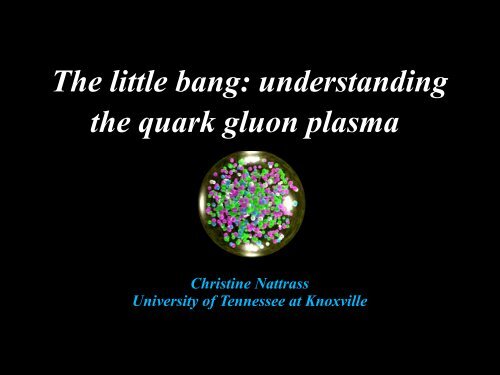Southeast Conference for Undergraduate Women ... - RHIG AT YALE
Southeast Conference for Undergraduate Women ... - RHIG AT YALE
Southeast Conference for Undergraduate Women ... - RHIG AT YALE
Create successful ePaper yourself
Turn your PDF publications into a flip-book with our unique Google optimized e-Paper software.
The little bang: understanding<br />
the quark gluon plasma<br />
Christine Nattrass<br />
University of Tennessee at Knoxville
Christine Nattrass (UTK), SCUWP, January 16, 2011<br />
2<br />
The Standard Model<br />
Weak <strong>for</strong>ce<br />
Electromagnetic <strong>for</strong>ce<br />
Strong <strong>for</strong>ce<br />
http://e4.physik.uni-dortmund.de/bin/view/<strong>AT</strong>LAS/SmBilderPhotoarchivePlugin_page=1&PhotoarchivePlugin_view=detailed
Christine Nattrass (UTK), SCUWP, January 16, 2011<br />
3<br />
What keeps the nucleus together<br />
●<br />
●<br />
●<br />
●<br />
Electric <strong>for</strong>ce: gets weaker as<br />
two objects get pulled apart<br />
Strong <strong>for</strong>ce: gets stronger as<br />
two objects get pulled apart –<br />
like a rubber band<br />
As we pull apart the quark and<br />
antiquark in a meson, at some<br />
point it takes less energy to<br />
make a quark-antiquark pair<br />
than to pull them further apart<br />
No free quarks - confinement<br />
strength<br />
Electromagnetic<br />
<strong>for</strong>ce<br />
distance<br />
Strong<br />
<strong>for</strong>ce
Christine Nattrass (UTK), SCUWP, January 16, 2011<br />
4<br />
Hadrons<br />
Baryons<br />
Mesons<br />
● 3 quarks/antiquarks<br />
● Color charge: red-green-blue<br />
● Quark-antiquark<br />
● Color charge: blue - anti-blue
Christine Nattrass (UTK), SCUWP, January 16, 2011<br />
5<br />
Is there way we can “free” the quarks<br />
Normal Nuclear Matter<br />
Quark Gluon Plasma<br />
Increasing density or temperature<br />
This figure and several others in this talk are copied from<br />
“Gauge Field Theories” by Mike Guidry
Christine Nattrass (UTK), SCUWP, January 16, 2011<br />
6<br />
How can we do this
Christine Nattrass (UTK), SCUWP, January 16, 2011<br />
7<br />
The phase transition in the laboratory
CMS<br />
8.6 km<br />
2.2 km<br />
LHCb<br />
ALICE<br />
<strong>AT</strong>LAS<br />
LHCf
Size: 16 x 26 meters<br />
Weight: 10,000 tons<br />
Detectors: 18<br />
Trigger detectors: When do we have a collision<br />
Tracking detectors: Where did the particle go<br />
Identification detectors: What kind of particle is it<br />
Calorimeters:<br />
Calorimeters: How much energy does the particle have<br />
9
First proton-proton collisions –<br />
November 23, 2009<br />
First lead-lead collisions November 7, 2010
Christine Nattrass (UTK), SCUWP, January 16, 2011<br />
11<br />
p+p collisions
Pb+Pb collisions<br />
Christine Nattrass (UTK), SCUWP, January 16, 2011<br />
12 5
Christine Nattrass (UTK), SCUWP, January 16, 2011<br />
13<br />
The ALICE Collaboration<br />
~1000 Members<br />
63% from CERN<br />
member states<br />
~30 Countries<br />
~100 Institutes<br />
~150 MCHF capital cost<br />
(+magnet)
Christine Nattrass (UTK), SCUWP, January 16, 2011<br />
14<br />
How do we know it's a QGP<br />
●<br />
●<br />
●<br />
●<br />
Jet quenching – high momentum quarks and gluons<br />
get stopped in the medium<br />
Hydrodynamical flow – it moves like a fluid of<br />
quarks and gluons<br />
Chemistry – what we produce is roughly at<br />
equlibrium<br />
Temperature – it is hot enough to match where we<br />
think it should be
Christine Nattrass (UTK), SCUWP, January 16, 2011<br />
15<br />
Jets<br />
nucleus<br />
nucleus<br />
●<br />
●<br />
●<br />
Quarks and gluons are confined – we don't see them outside of mesons and<br />
baryons<br />
Instead we see a cone of particles around the outgoing quark or gluon<br />
Looking at jets analogous to spectroscopy
Christine Nattrass (UTK), SCUWP, January 16, 2011<br />
16<br />
Quenched jets<br />
nucleus<br />
●<br />
●<br />
nucleus<br />
One of the jets is absorbed by the medium<br />
The quark or gluon has equilibrated with the medium<br />
● Phys. Rev. Lett. 105, 252303 (2010)
Christine Nattrass (UTK), SCUWP, January 16, 2011<br />
17<br />
What we have learned so far<br />
●<br />
The QGP is a dense, hot liquid of quarks and gluons<br />
●<br />
●<br />
●<br />
Lowest viscosity fluid ever measured<br />
It is highly opaque – it stops even fast quarks<br />
It's roughly at chemical equilibrium
A bit about me<br />
●<br />
●<br />
●<br />
●<br />
●<br />
●<br />
●<br />
●<br />
●<br />
Current position: Post doctoral researcher at the University of<br />
Tennessee at Knoxville<br />
●<br />
On ALICE (LHC) & PHENIX (RHIC) experiments<br />
Degrees<br />
●<br />
●<br />
B.S. Colorado State University, 2003: Physics, biochemistry, and physical<br />
science majors with minors in chemistry, math, and German<br />
M.Phil., M.Sci., and Ph.D. Yale University, 2009: Physics<br />
on STAR (RHIC) experiment<br />
I did undergraduate research – at UNC Chapel Hill, Colorado State,<br />
University of Leiden (Netherlands), and CERN (Switzerland)<br />
I did not take physics or calculus in high school and only declared a<br />
physics major in my second year<br />
I started as a biochemistry major<br />
I paid off my undergraduate student loans in grad school by teaching<br />
extra<br />
I spent about 4 months out of the year out of town last year and<br />
racked up 40k airline miles<br />
My husband is a Czech nuclear physicist, he still lives in New York,<br />
and we we went to a nuclear reactor on our honeymoon<br />
Hobbies: running, cooking, brewing beer & wine, cello, biking,<br />
hiking<br />
Christine Nattrass (UTK), SCUWP, January 16, 2011<br />
18
Christine Nattrass (UTK), SCUWP, January 16, 2011<br />
19<br />
What I spend my time doing<br />
●<br />
Programming (c++) - analyzing data<br />
● Writing and giving talks – 3 research talks, 1<br />
seminar, 2 posters, 1 software tutorial, and lots of<br />
talks (>30) at internal meetings in 2010<br />
●<br />
●<br />
●<br />
●<br />
●<br />
●<br />
●<br />
Hardware work: assembling & testing the detector<br />
Working with graduate students<br />
Outreach: blogging <strong>for</strong> ALICE, giving tours of<br />
PHENIX to the public...<br />
Writing papers and conference proceedings<br />
Reviewing the work of my collaborators<br />
Running our journal club<br />
Reading papers<br />
● Taking shifts – including being on call 24/7
Christine Nattrass (UTK), SCUWP, January 16, 2011<br />
20<br />
Careers in high energy physics<br />
●<br />
You should consider high energy physics if...<br />
●<br />
●<br />
●<br />
●<br />
●<br />
You like programming and working with computers<br />
You're a people person – and don't mind working with 1000 people<br />
You like to travel around the world – and work<br />
You enjoy giving talks<br />
Common career options <strong>for</strong> people with a Ph.D. in high<br />
energy physics<br />
●<br />
●<br />
●<br />
●<br />
●<br />
Academia – research and teaching universities<br />
Research at a National Laboratory<br />
National security<br />
Finance<br />
Computer programming
Christine Nattrass (UTK), SCUWP, January 16, 2011<br />
21<br />
Resources<br />
●<br />
US LHC blog and Facebook page<br />
●<br />
Experiments<br />
● Relativistic Heavy Ion Collider: STAR PHENIX<br />
●<br />
●<br />
●<br />
●<br />
● Large Hadron Collider: ALICE <strong>AT</strong>LAS CMS LHCb<br />
TOTEM<br />
Event displays and pretty pictures from ALICE<br />
Really cool <strong>AT</strong>LAS event animation<br />
Links to articles in the press on PHENIX<br />
Scientific American article
Christine Nattrass (UTK), SCUWP, January 16, 2011<br />
22<br />
US Universities with graduate programs in experimental heavy ion physics<br />
●<br />
STAR<br />
●<br />
●<br />
●<br />
●<br />
●<br />
●<br />
●<br />
●<br />
●<br />
●<br />
●<br />
●<br />
●<br />
●<br />
University of Cali<strong>for</strong>nia at Davis<br />
University of Cali<strong>for</strong>nia Los Angelos<br />
University of Houston<br />
University of Illinois at Chicago<br />
Creighton University (masters only)<br />
Kent State University<br />
Michigan State University<br />
Ohio State University<br />
Purdue University<br />
Texas A&M University<br />
University of Texas Austin<br />
University of Washington<br />
Wayne State University<br />
Yale University<br />
Relativistic Heavy Ion Collider<br />
●<br />
PHENIX<br />
●<br />
●<br />
●<br />
●<br />
●<br />
●<br />
●<br />
●<br />
●<br />
●<br />
University of Cali<strong>for</strong>nia Riverside<br />
University of Colorado Boulder<br />
Columbia University<br />
Florida State University<br />
Georgia State University<br />
Iowa State University<br />
Ohio University<br />
State University of New York<br />
(Chemistry & Physics departments)<br />
University of Tennessee at Knoxville<br />
Vanderbilt University
US Universities with graduate programs in experimental heavy ion physics<br />
Large Hadron Collider<br />
●<br />
ALICE<br />
●<br />
CMS<br />
●<br />
University of Texas Austin<br />
●<br />
University of Cali<strong>for</strong>nia Davis<br />
●<br />
Chicago State University<br />
●<br />
University of Illinois Chicago<br />
●<br />
Ohio State University<br />
●<br />
University of Kansas<br />
●<br />
Wayne State University<br />
●<br />
University of Maryland<br />
●<br />
University of Texas Houston<br />
●<br />
University of Iowa<br />
●<br />
University of Tennessee Knoxville<br />
●<br />
Rutgers University<br />
●<br />
Yale University<br />
●<br />
Massachusetts Institute of Technology<br />
●<br />
Creighton University (masters only)<br />
●<br />
Vanderbilt University<br />
●<br />
Purdue University<br />
●<br />
<strong>AT</strong>LAS<br />
●<br />
Columbia University<br />
Christine Nattrass (UTK), SCUWP, January 16, 2011<br />
23
Christine Nattrass (UTK), SCUWP, January 16, 2011<br />
24<br />
Evolution of the Universe<br />
10 -44 sec<br />
10 -35 sec<br />
10 -35 sec<br />
2 10 -10 sec<br />
2·10 -6 sec<br />
6 sec<br />
The universe gets<br />
cooler!<br />
Reheating matter<br />
Need temperatures<br />
around 1.5·10 12 K<br />
~10 6 times hotter than<br />
the core of the sun<br />
3 min<br />
10 6 yrs<br />
10 9 yrs
Christine Nattrass (UTK), SCUWP, January 16, 2011<br />
25<br />
Making a QGP in the laboratory<br />
Relativistic pancakes<br />
Quark soup<br />
Explosive hadron soda
Christine Nattrass (UTK), SCUWP, January 16, 2011<br />
26<br />
Phase Diagram of Nuclear Matter
Christine Nattrass (UTK), SCUWP, January 16, 2011<br />
27<br />
Hydrodynamical flow<br />
Au+Au √s NN<br />
= 200 GeV<br />
b=7 fm<br />
Particles pushed out<br />
Equipotential lines<br />
arXiv:nucl-th/0305084<br />
●<br />
●<br />
●<br />
When nuclei collide, the overlap region is roughly elliptical<br />
If we have a fluid when we collide nuclei, there will be pressure gradients, pushing particles out<br />
We have measured this – and the liquid is made of quarks and gluons
Christine Nattrass (UTK), SCUWP, January 16, 2011<br />
28<br />
Chemistry - equilibrium<br />
Nuclear Physics A Volume 757, 102-183<br />
●<br />
●<br />
Ratios of particles expected from a model<br />
Even strange quarks are at equilibrium!
Christine Nattrass (UTK), SCUWP, January 16, 2011<br />
29<br />
A simple picture of a heavy ion collision
Christine Nattrass (UTK), SCUWP, January 16, 2011<br />
30<br />
Jets as a probe of the quark gluon plasma
Christine Nattrass (UTK), SCUWP, January 16, 2011<br />
31<br />
One jet “absorbed” by the medium





